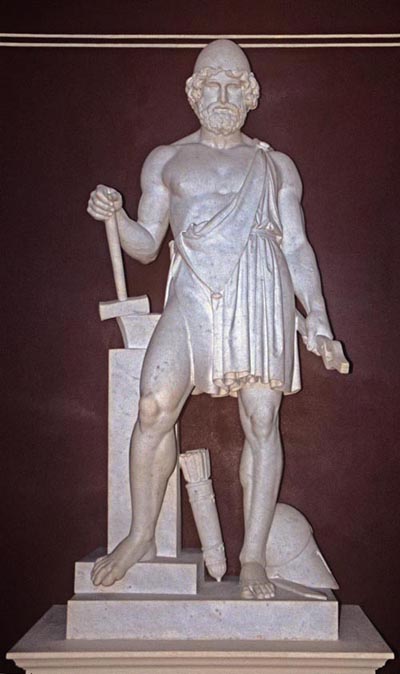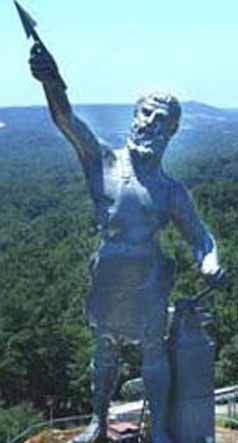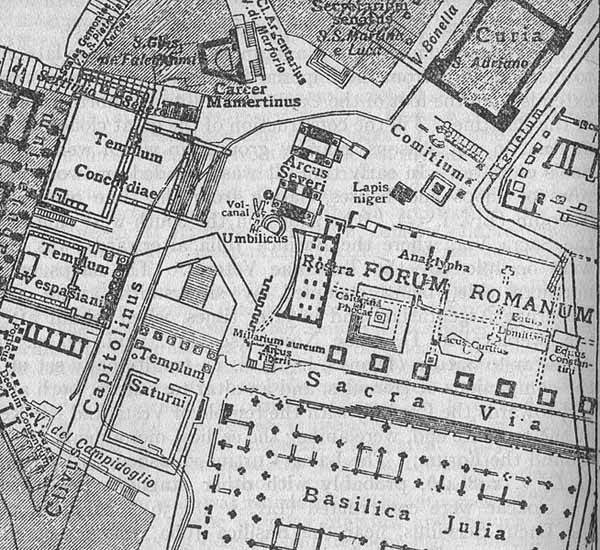



In ancient Roman religion and myth, Vulcan (Latin: Vulcanus) is the god of both beneficial and hindering fire, including the fire of volcanoes, and the manufacturer of art, arms, iron, and armor for gods and heroes. His forge was believed to be situated underneath Mount Aetna in Sicily. Vulcan is often depicted with a blacksmith's hammer.
The Romans identified Vulcan with the Greek smith-god Hephaestus, and he became associated like his Greek counterpart with the constructive use of fire in metalworking. A fragment of a Greek pot showing Hephaestus found at the Volcanal has been dated to the 6th century BC, suggesting that the two gods were already associated at this date. However, Vulcan had a stronger association than Hephaestus with fire's destructive capacity, and a major concern of his worshippers was to encourage the god to avert harmful fires. His festival, the Vulcanalia, was celebrated on August 23 each year, when the summer heat placed crops and granaries most at risk of burning.
During the festival bonfires were created in honor of the god, into which live fish or small animals were thrown as a sacrifice, to be consumed in the place of humans. Vulcan was among the gods placated after the Great Fire of Rome in AD 64. In response to the same fire, Domitian (emperor 81-96) established a new altar to Vulcan on the Quirinal Hill. At the same time a red bull-calf and red boar were added to the sacrifices made on the Vulcanalia, at least in that region of the city.
In addition to the Volcanalia on August 23, the date May 23, which was the second of the two annual Tubilustria or ceremonies for the purification of trumpets, was sacred to Vulcan.
He is also called Mulciber ("softener") in Roman mythology and Sethlans in Etruscan mythology.
Vulcan belonged to the most ancient platform of Roman religion.
The word volcano is derived from the name of Vulcano, a volcanic island in the Aeolian Islands of Italy whose name in turn originates from Vulcan.
Vulcan was the son of Jupiter and Juno, and husband of Maia and Venus. Vulcan made the thrones for the other gods on Mt. Olympus.
Through his identification with the Hephaestus of Greek mythology, he came to be considered as the manufacturer of art, arms, iron, jewelery and armor for various gods and heroes, including the thunderbolts of Jupiter. He was the son of Jupiter and Juno, and husband of Maia and Venus. His smithy was believed to be situated underneath Mount Etna in Sicily. As the son of Jupiter, the king of the gods, and Juno, the queen of the gods, Vulcan should have been quite handsome, but, baby Vulcan was small and ugly with a red, bawling face. Juno was so horrified that she hurled the tiny baby off the top of Mount Olympus.
Vulcan fell down for a day and a night, landing in the sea. Unfortunately, one of his legs broke as he hit the water, and never developed properly. From the surface, Vulcan sunk like a pebble to the cool blue depths where the sea-nymph, Thetis, found him and took him to her underwater grotto, and raised him as her own son.
Vulcan had a happy childhood with dolphins as his playmates and pearls as his toys. Late in his childhood, he found the remains of a fisherman's fire on the beach and became fascinated with an unextinguished coal, still red-hot and glowing.
Vulcan carefully shut this precious coal in a clamshell and took it back to his underwater grotto and made a fire with it. On the first day after, Vulcan stared at this fire for hours on end.
On the second day, he discovered that when he made the fire hotter with bellows, certain stones sweated iron, silver or gold.
On the third day he beat the cooled metal into shapes: bracelets, chains, swords and shields. Vulcan made pearl-handled knives and spoons for his foster mother, he made a silver chariot for himself, and bridles so that seahorses could transport him quickly. He even made slave-girls of gold to wait on him and do his bidding.
Later, Thetis left her underwater grotto to attend a dinner party on Mount Olympus wearing a beautiful necklace of silver and sapphires, which Vulcan had made for her. Juno admired the necklace and asked as to where she could get one. Thetis became flustered causing Juno to become suspicious and, at last, the queen god discovered the truth: the baby she had once rejected had grown into a talented blacksmith.
Juno was furious and demanded that Vulcan return home, a demand that he refused. However he did send Juno a beautifully constructed chair made of silver and gold, inlaid with mother-of-pearl. Juno was delighted with this gift but, as soon as she sat in it her weight triggered hidden springs and metal bands sprung forth to hold her fast. The more she shrieked and struggled the more firmly the mechanical throne gripped her; the chair was a cleverly designed trap.
For three days Juno sat fuming, still trapped in Vulcan's chair, she couldn't sleep, she couldn't stretch, she couldn't eat. It was Jupiter who finally saved the day, he promised that if Vulcan released Juno he would give him a wife, Venus the goddess of love and beauty. Vulcan agreed and married Venus. He later built a smithy under Mount Etna on the island of Sicily. It was said that whenever Venus is unfaithful, Vulcan grows angry and beats the red-hot metal with such a force that sparks and smoke rise up from the top of the mountain, to create a volcanic eruption. According to Virgil, Vulcan was the father of Caeculus.
To punish mankind for stealing the secrets of fire, Jupiter ordered the other gods to make a poisoned gift for man. Vulcan's contribution to the beautiful and foolish Pandora was to mould her from clay and to give her form. He also made the thrones for the other gods on Mount Olympus.

Map (1926) of the western end of the Roman Forum: The Volcanal is indicated between the Arch of Severus and the stairs of the Temple of Concord, just northwest of the Umbilicus and Rostra. It appears to have played an important role in the civic rituals of the archaic Roman Kingdom. Dedicated to Vulcan, it was traditionally considered to commemorate the spot where the legendary figures Romulus and Tatius concluded the peace treaty between the tribes known as the Latins - on the Palatine Hill - and the Sabines - on the Quirinal and Esquiline. This famous merger of the hill-villages was said to be the foundation of the Roman state.
Vulcan also had a temple on the Campus Martius, which was in existence by 214 BC. The Romans identified Vulcan with the Greek smith-god Hephaestus, and he became associated like his Greek counterpart with the constructive use of fire in metalworking. A fragment of a Greek pot showing Hephaestus found at the Volcanal has been dated to the 6th century BC, suggesting that the two gods were already associated at this date. However, Vulcan had a stronger association than Hephaestus with fire's destructive capacity, and a major concern of his worshippers was to encourage the god to avert harmful fires.
The main and most ancient sanctuary of Vulcan in Rome was the Volcanal, located in the area Volcani, an open air space at the foot of Capitol Hill, in the northwestern corner of the Roman Forum, with an ara dedicated to the god and a perennial fire. It was one of the most ancient Roman shrines. According to Roman tradititon the sanctuary had been dedicated by Romulus. He had placed on the site a bronze quadriga dedicated to the god, a war pray of the Fidenates.
According to Plutarch though the war in question was that against Cameria, that occurred sixteen years after the foundation of Rome. There Romulus would have also dedicated to Vulcan a statue of himself and an inscription in Greek listing his successes. Plutarch states that Romulus was represented crowned by Victory. Moreover he would have planted a sacred lotus tree in the sanctuary that was still living at the time of Pliny the Elder and was said to be as old as the city.
The Volcanal was perhaps used as a cremation site as suggested by the early use of the Forum as a burial site.
According to Samuel Ball Platner in the course of time the Volcanal should have been more and more encroached upon by the surrounding buildings until it was totally covered over. Nonetheless cult was still alive in the first half of the imperial era, as is testified by the finding of a dedica of Augustus's dating from 9 BC.
At the beginning of 20th century behind the Arch of Septimius Severus were found some ancient tufaceous foundations that probably belonged to the Volcanal and traces of a rocky platform, 3.95 meters long and 2.80 meters wide, that had been covered with concrete and painted in red. Its upper surface is dug by several narrow channels and in front of there are the remains of a draining channel made of tufaceous slabs. The hypothesis was made that this was Vulcan's ara itself. The rock shows signs of damages and repairs. On the surface there are some hollows, either round or square, that bear resemblance to graves and were interpreted as such in the past, particularly by Von Duhn. After the discovery of cremation tombs in the Forum the last scholar maintained that the Volcanal was originally the site were corpses were cremated.
The festival of Vulcan, the Vulcanalia, was celebrated on August 23 each year, when the summer heat placed crops and granaries most at risk of burning. During the festival bonfires were created in honor of the god, into which live fish or small animals were thrown as a sacrifice, to be consumed in the place of humans.
It is recorded that during the Vulcanalia people used to hang their cloths and fabrics under the sun. This habit might reflect a theologic connection between Vulcan and the divinized sun.
Another custom observed in this day required that one should start working at the light of a candle, probably to propitiate a beneficial use of fire by the god.
In addition to the Volcanalia on August 23, the date May 23, which was the second of the two annual Tubilustria or ceremonies for the purification of trumpets, was sacred to Vulcan.
A flamen, one of the flamines minores, named flamen Volcanalis was preposed to the cult of the god. The flamen Volcanalis officed a sacrifice to goddess Maia, held every year at the Kalendae of May.
The Ludi Volcanalici, held just once on August 23, 20 BC, within the temple precinct of Vulcan, were used by Augustus to mark the treaty with Parthia and the return of the legionary standards that had been lost at the Battle of Carrhae in 53 BC.
Vulcan was among the gods placated after the Great Fire of Rome in AD 64. In response to the same fire, Domitian (emperor 81-96) established a new altar to Vulcan on the Quirinal Hill. At the same time a red bull-calf and red boar were added to the sacrifices made on the Vulcanalia, at least in that region of the city.
The nature of the god is connected to religious ideas concerning fire.
The Roman concept of the god seems to be connected both to the destructive and fertilizing powers of fire.
In the first aspect he is worshipped to avert its potential danger to harvested wheat in the Volcanalia and his cult is located outside the boundaries of the original city to avoid its causing fires in the city itself.
This power is however considered useful if directed against enemies and such a choice for the location of the god's cult could be interpreted in this way too. The same idea underlies the dedication of the arms of the defeated enemies, as well as those of the survived general in a devotion ritual to the god.
Through comparative interpretation this aspect has been connected to the third (or defensive) fire in the Vedic theory of the three sacrificial fires.
Another meaning of Vulcan is related to male fertilizing power. In various Latin and Roman legends he is the father of famous characters, such as the founder of Praeneste Caeculus, Cacus, a primordial monstrous being that inhabited the site of the Aventine in Rome and Roman king Servius Tullius. In a variant of the story of the birth of Romulus the details are identical even though Vulcan is not explicitly mentioned.
Some scholars think that he might be the unknown god who impregnated goddesses Fortuna Primigenia at Praeneste and Feronia at Anxur. In this case he would be the father of Jupiter. However this view is in conflict with that which links the goddess to Jupiter, as his daughter (puer Jovis) and his mother too, as primigenia, meaning "primordial".
In all of the above mentioned stories the god's fertilizing power is related to that of the fire of the house hearth.
In the case of Caeculus, his mother was impregnated by a spark that dropped on her womb from the hearth while she was sitting nearby. Servius Tullius's mother Ocresia was impregnated by a male sex organ that miraculously appeared in the ashes of the sacrificial ara, at the order of Tanaquil, Tarquinius Priscus's wife.[29] Pliny the Elder tells the same story, but states that the father was the Lar familiaris. The divinity of the child was recognized when his head was surrounded by flames and he remained unharmed.
Through the comparative analysis of these myths archaeologist Andrea Carandini opines that Cacus and Caca were the sons of Vulcan and of a local divine being or a virgin as in the case of Caeculus. Cacus and Caca would represent the metallurgic and the domestic fire, projections of Vulcan and of Vesta.
These legends date back to the time of preurban Latium. Their meaning is quite clear: at the divine level Vulcan impregnates a virgin goddess and generates Jupiter, the king of the gods; at the human level he impregnates a local virgin (perhaps of royal descent) and generates a king.
The first mention of a ritual connection between Vulcan and Vesta is the lectisternium of 217 BC. Other facts hinting to this connection seem to be the relative proximity of the two sanctuaries and Dionysius of Halicarnassus's testimony that both cults had been introduced to Rome by Titus Tatius to comply with a vow he had made in battle. Varro confirms the fact.
Vulcan is related to two equally ancient female goddesses Stata Mater, perhaps the goddess who stops fires and Maia.
Herbert Jennings Rose interprets Maia as a goddess related to growth by connecting her name with IE root *MAG. Macrobius relates Cincius's opinion that Vulcan's female companion is Maia. Cincius justifies his view on the grounds that the flamen Volcanalis sacrificed to her at the Kalendae of May. In Piso's view the companion of the god is Maiestas.
According to Gellius too Maia was associated to Vulcan and he backs his view by quoting the Roman priests's ritual prayers in use.
Moreover Maiestas and Maia are possibly the same divine person: compare Ovid's explanations of the meaning of the name month May.
The god is the patron of trades related to ovens (cooks, bakers, confectioners) as it is attested in the works of Plautus, Apuleius (the god is the cook at the wedding of Amor and Psyche) and in Vespa's short poem in the Anthologia Latina about the litigation between a cook and a baker.
Vulcan of the alchemists was the patron deity of alchemy. It was also known to be a symbol of the hermetic art. Despite being important in Egyptian and Greek religion, it was the Renaissance physician/alchemist Paracelsus who first introduced the mythological figure of Vulcan. To Paracelsus, Vulcan was synonymous with both the alchemist/physician's manipulation of fire, heating and distilling of nature's properties for medicine, and the transforming power and creative potential locked within Man, the greater invisible Man or anthropos, slumbering within.
The alchemists' adoption of the mythic figure of Vulcan may be interpreted on several levels. At the lowest scale of interpretation, Vulcan represents the cunning amoral demiurge who blindly gains power over Nature without integrity; this mundane level anticipates the nascent Industrial Revolution of the 18th century.
The activities of the extraction of coal from mines to fuel colossal Furnaces to manufacture Steel and Iron on a gigantic scale and the development of the railroad and steam-train throughout Europe and North America are both decidedly Vulcan-like activities and in many ways, the general "business" of the Protestant work ethic and industrialized Western society, is strongly reflected in this archetypal figure. At a higher level of interpretation Vulcan is transformed to become an inspired apostle, the visionary capable of releasing Mankind from the bonds of unknowingness and darkness.
The transforming power of Vulcan the "higher man" and anthropos figure of the alchemists has today devolved into the negative aspects of a demi-urge figure; none other than the modern technological man, who, divorced from God, forges his own destiny independent of Religion, Divine Love or theological considerations towards a brave new world or utopia.
Fire and alchemy are not only for the transmutation gold - but more importantly - the alchemy of consciousness in time. Fire is also associated with the Phoenix.
ANCIENT AND LOST CIVILIZATIONS